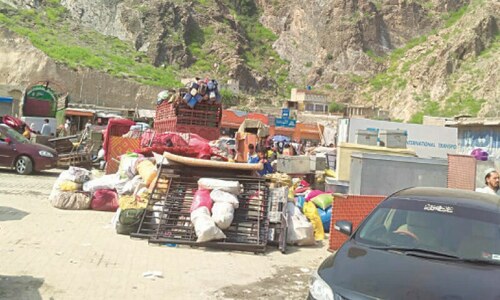PESHAWAR, Oct 5: In a major deviation from the existing and previous local government systems, the proposed Khyber Pakhtunkhwa Local Government Act 2013 provides for direct elections on general seats of district and tehsil councils.
While the proposed law has major resemblance with the Local Government Ordinance 2001, introduced during the military government of Pervez Musharraf, it differs as far as election for different seats is concerned, specially the seats reserved for women, non-Muslims, workers and peasants.
The draft bill of the proposed law is set to be introduced in the provincial assembly in its session starting from coming Monday. It envisages filling of the reserved seats in tehsil and district councils on the basis of proportional representation system of party’s list of candidates on the pattern similar to that of filling such seats in the national and provincial assemblies.
Instead of union councils the proposed law includes village councils in rural areas and neighbourhood councils in urban areas.
In the Musharraf era system the nazim of a union council was a member of district council whereas the naib nazim was member of the relevant tehsil council. Similarly, the present Local Government Act 2012 provides that a chairman of a union council shall be a member of the district council. However, now the Pakistan Tehreek-i-Insaf-led government has proposed that the wards for the general seats in tehsil council and district council shall be single member territorial wards.
Elections of all the local councils would be held on the basis of joint electorate and adult franchise. However, it is proposed that the polls for village and neighbourhood councils would be held on non-party basis whereas rest of the councils would be on party basis.
According to Section 74 (3) of the proposed law each tehsil or, as the case may be, each district shall be a single ward for all seats reserved for women, peasants and workers, youth and non-Muslims allocated to the tehsil or district. Furthermore, Section 74 (4) provides that “Members to fill seats reserved for women, peasants and workers, youth and non-Muslims in the tehsil council and district council shall be elected through proportional representation system of political parties’ list of candidates on the basis of the total number of general seats secured by each political party in the respective local council.”
In the previous 2001 law the seats reserved for women, peasants and workers and minorities in district and tehsil councils were filled through indirect elections for which the electoral college included all the elected councillors of all the union councils in a district or a tehsil, as the case may be.
The proposed law provides that the electoral college for the election of nazim and naib nazim of a district council should be all the members of the district council. Similarly, the electoral college for the election of nazim and naib nazim of a tehsil council shall be members of the said tehsil council.
Furthermore, the proposed law envisages that elections to district and tehsil councils shall be held on party basis and a political party shall be eligible to obtain an election symbol for contesting these elections.
It also empowers a member elected on independent basis to join any political party within three days of the publication in official gazette of the names of the returned candidates and the total number of seats won by a political party would also include those independents.
Under the proposed law the provincial government shall within 60 days of the commencement of the law notify village and neighbourhood councils in all districts. Each village and neighbourhood council would comprise 10 to 15 members, including five to 10 Muslim members, determined on the basis of population, elected to general seats; two members elected to seats reserved for women; and one member each elected to seat reserved for peasants and workers, youth and non-Muslims.
The village council or neighbourhood council, as the case may be, shall be a multi-member ward for election of members. Furthermore, the candidates securing the highest and second highest number of votes in the election on general seats of the village council or neighbourhood council, shall respectively be the nazim and naib nazim of that council.











































